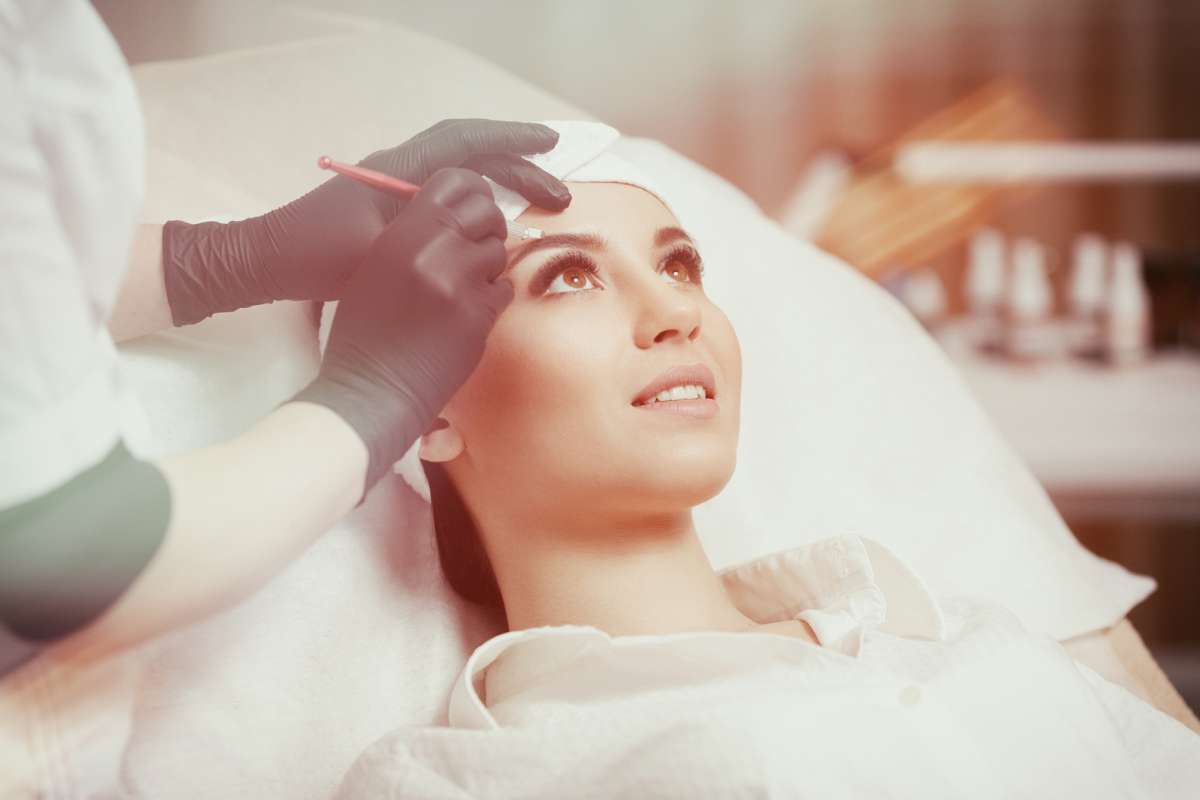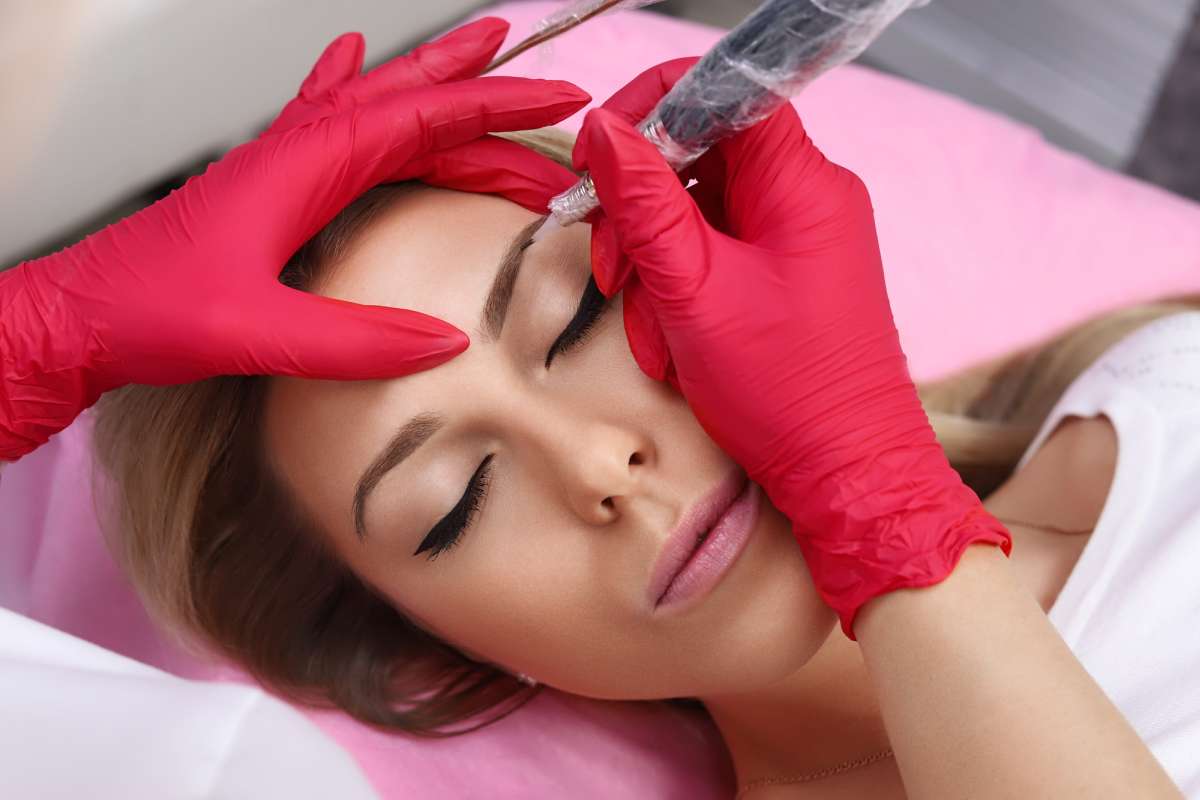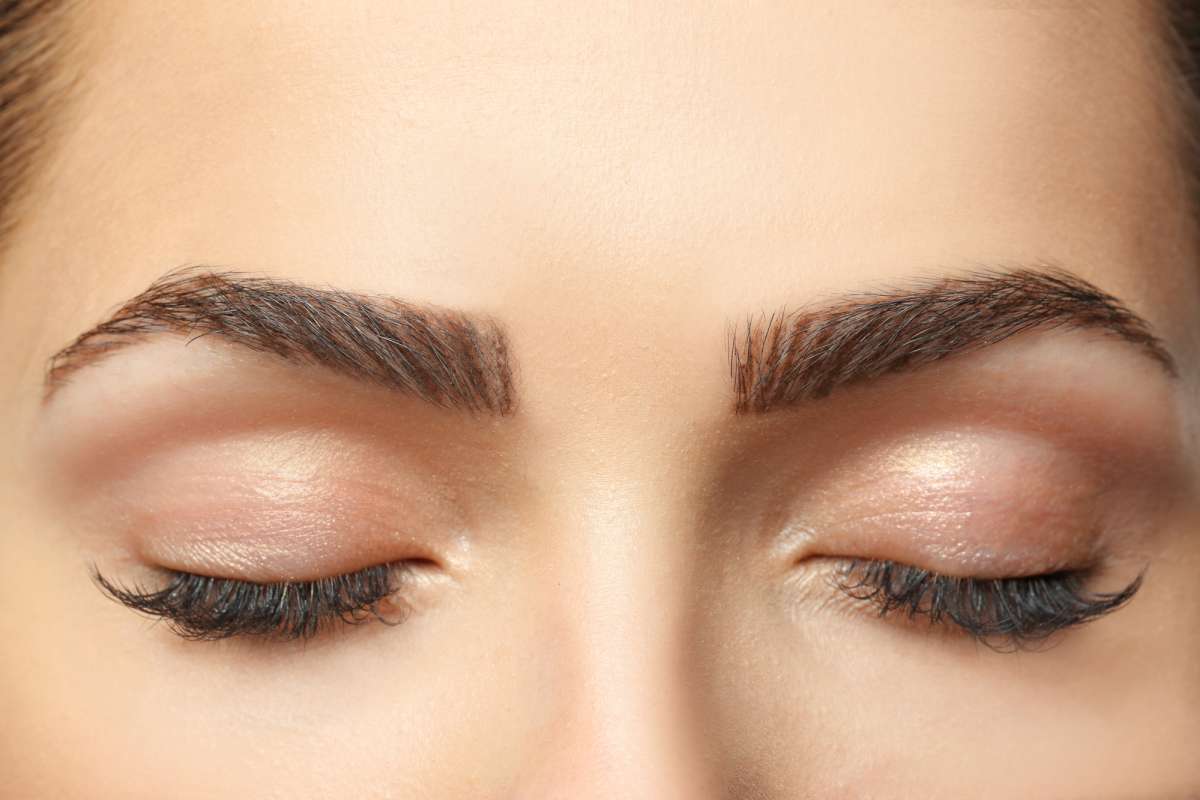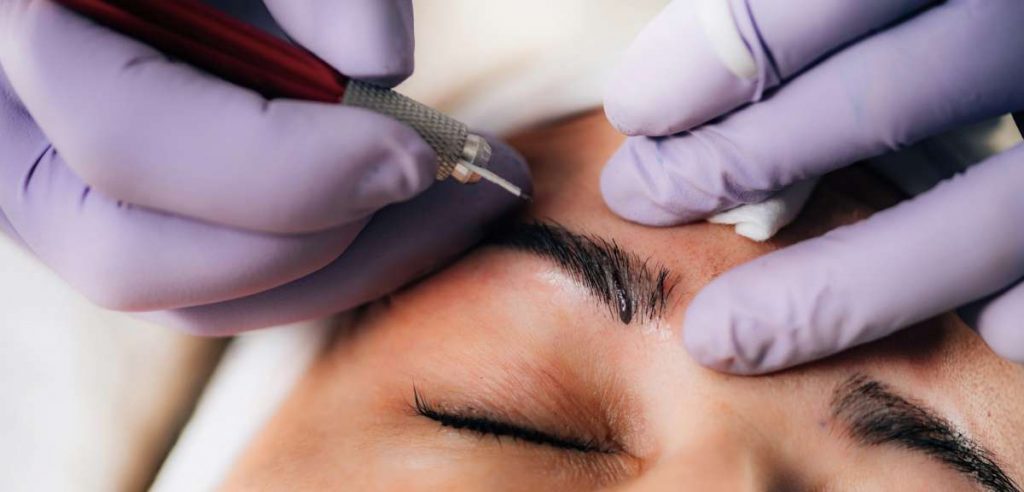When it comes to eyebrows, thin is no longer considered to be fashionable. On the other hand, having barely-there brows that just won't develop can be caused by causes such as over-tweezing, hypothyroidism, or even just heredity. Eyebrow microblading is a type of semi-permanent tattooing that has become more popular as a remedy to this problem. This procedure involves a skilled expert using a specific pen to create the appearance of individual hairs within the eyebrows. A Florida microblading specialist named Trish Dinh posted a before and after picture of a client's brows on Instagram, comparing the appearance of the brows before and after the microblading procedure. The outcome is brows that appear full, contoured, and natural.
It doesn't matter if you overplucked your eyebrows in the 90s or if you just can't get enough of Cara Delevingne and Solange Knowles' exquisite brows; microblading could be the answer to your brow envy. However, you are most likely on the fence about it, particularly after hearing those horrible tales of microblading gone awry. Although one woman suffered a skin illness that put her life in danger after receiving a discounted session, the truth is that microblading is perfectly safe as long as it is performed by a qualified professional who possesses the necessary credentials.
However, because microblading is still a relatively new notion in terms of beauty, it can be difficult to determine what is normal and what is not, as well as whether or not you would qualify as a candidate for the treatment. We consulted with brow experts Mary Torres, Naomi Sinead, Narissa Matheney, and Veronika Dmitriyeva, to get their feedback. It's not surprising that many women are thinking about undergoing the most recent cosmetic procedure made famous by social media's love for bold brows with dramatic before and after photos of microblading eyebrows. Now that thick brows are back in fashion, it makes sense that many women are considering it.

What Is Microblading?
When performing microblading, the technician will use very fine blades to create microscopic cuts that resemble hairs just above the dermis layer of the skin. The pigment will then be deposited directly into these microscopic cuts. As a direct consequence of this, your eyebrows will gradually lose their colour as the years pass, necessitating periodic touch-ups. Because microblading is a semipermanent technique, the results of the treatment on your eyebrows might last anywhere from one to three years. In contrast, a tattoo artist injects ink underneath the dermis, making the results extremely long-lasting and permanent. This is not the case here.
According to Dmitriyeva, in order to achieve the desired effect, a technician will manually puncture and penetrate the skin with the pigment colour that works best to complement the client's natural brow tone. This will create the vision of the client's brows being darker, maintainerd and more fuller.
The outcome of microblading is brows that appear more natural and fuller than they were before the treatment was performed. But, if you are expecting a child or are nursing a child, there are some additional things you should know about this popular new cosmetic therapy.
This is a relatively new service that considerably differs from tattooed cosmetics of the past in several key ways: the appearance imitates natural brow hairs, and the colour match is also significantly improved. In place of a traditional tattoo gun, shallow wounds are made on the skin, which are then filled with ink.
When applying colour pigments designed to look like real hair, an esthetician will use an instrument called a microblade. Because the colour effect will wear off over time, periodic touch-ups could be required to keep the intended appearance intact. The method of microblading is supposed to result in eyebrows that have a more defined and natural appearance; nevertheless, it normally takes some time to perfect.
The first treatment can take anywhere from one to two hours to complete, and the results of that treatment can be seen almost immediately in the form of darker eyebrows. After a few weeks, the colour can start to fade, and a touch-up might be necessary then. It has the potential to be wonderful; yet, not everyone should try it.
Even if you were born with naturally large eyebrows, you can still benefit from having them microbladed so that they look even fuller. Microblading is not just for people who have thin or sparse eyebrows. But the results are particularly astonishing on persons who have very little eyebrow hair (and can be nearly life-changing for people who suffer from alopecia).
Microshading, on the other hand, is typically better suited for oily or sensitive skin types. It is also ideal for anyone who favours the makeup look 24/7 due to the powdered effect that it produces. Sinead explains that the technician uses a "(round) needle to poke and deposit pigment above the dermis, focusing on areas around or directly on top of the microblading," rather than making hairlike strokes along the brow. The one and only drawback? Because of the need for a certain level of knowledge, the shading process takes longer, adds an additional $75 to $100 to the total cost, and makes the user feel slightly more uneasy.
How Can You Avoid The Biggest Risks?
Microblading is an alternative to cosmetic eyeliner tattooing that is significantly less invasive and does not require any recovery time on the patient's part. The danger of infection is, however, remains the most significant one; hence, you should conduct your research and select a technician who has a good reputation and who works in a clean atmosphere before undergoing the procedure. Sinead advises, "Your technician ought to have a substantial amount of experience in the field of skincare." "This includes possessing credentials in permanent cosmetics and blood-borne infections," the speaker continued.
It is a good idea to check over the technician's internet portfolio, but you should keep in mind that it is extremely simple to steal the before-and-after images of another artist or to use Photoshop to make one's work look better than it actually is. Instead, you should look for films that show the face of the technician as they are performing the treatment. Are they putting on gloves in that picture? Are they removing the protective wrapping from the apparatus before using it?
Another thing to look out for is pigments that are the wrong colour. "Black pigment is unreliable." According to Matheney. Even when working on someone with very dark brows, technicians performing microblading should only use a very dark brown pigment.
After you have located a technician who possesses the necessary credentials and experience, you should enquire about scheduling a consultation. Be wary of any individual who dismisses your concerns, requests payment in advance for the session, or refuses to provide a free allergy patch test. Sinead believes that the tattoists should be able to explain everything, from where they get their ink to the best way to take care of your brows after getting their work done.
When seeking any type of medical therapy, Prather advises patients to make sure they are aware of the credentials of the individual who will be carrying out the procedure. "You need to find out where this person received their training. How long have they been offering these kinds of treatments? What kind of reputation does the office have? By going through this list, you can guarantee that the person who is treating you is employing a sterile approach and taking the required safety procedures to reduce the possibility of transmission, scarring, and infection the of blood-borne products. In most cases, board-certified dermatologists do not execute the microblading technique themselves; rather, they are able to recommend a trustworthy aesthetician or licenced specialist who can assist you in completing this surgery in a risk-free manner. "If you know people who have had microblading done in the past, ask them about their experiences (or for a suggestion), but ultimately, you should listen to your intuition more than anything else.
It can be a time-consuming and frustrating process to bring your overplucked eyebrows back from a sparse and patchy appearance to a thick and full one. If you're bored of having to draw them on with a pencil every morning and you've already tried every growth serum and brow gel available at the beauty shop, you might be craving for a solution that's a little more permanent. Enter microblading: A specialist will sculpt your eyebrows using this treatment, which is only semi-permanent, by drawing individual hairs on with a specialised cosmetic eyebrow pen. According to Hibba Kapil, proprietor of the Hibba Beauty salon in New York City, "hair - like structures strokes are produced in between the brow hairs to fill in short or sparse brows." "Filling in short or sparse brows can be accomplished by using this technique." The end effect is brows that are fuller, darker, and appear more natural, all without requiring regular maintenance.
The therapy can be found in spas and salons all around the country, and it is popular among A-list celebrities. In a recent essay she wrote for Vogue, Lena Dunham discussed her recent decision to have her eyebrows microbladed. In the post, she stated that the results were better than she had hoped for: She wrote in her journal that "When I eventually sat up, I was too startled to talk." The author writes, "On my face were two perfect brows, the same hard to catch brown as the hair on my head, multidimensional, thick in all the right places."
The microblading procedure that Dunham had done went really well. Should you give thought to having the treatment done to provide your own eyebrows an enhancement? A dermatologist based in New York City named Debra Jaliman, MD, states that "it's a safe and successful technique when done by someone skilled" when referring to laser skin resurfacing. Nevertheless, there is a catch: "It is imperative that the procedure be carried out in clean surroundings. In that case, you run the risk of contracting a skin infection such as staph, or even herpes."
On the other hand, this is one form of beauty treatment that you should absolutely have carried out by a trained specialist. A significant danger of infection is posed by the use of at-home microblading kits, according to Dr. Jaliman; however, should you really tattoo yourself in the first place? People who suffer from eczema and rosacea are cautioned by her to stay away from the product.

Microblading Risks
No cosmetic treatment, just like an unbalanced diet (as when people take the IIFYM philosophy too far...), is completely devoid of any potential adverse consequences. According to Prochnow, some patients report experiencing some scabbing and flaking after the procedure. When you cut the skin in any way, you run the danger of infection; nevertheless, the likelihood of contracting an infection is low if you carefully manage the region that has been microbladed. According to Prochnow, in order to prevent scabbing, "you want to make sure that you keep the region moist with Vaseline or Aquaphor," but you should refrain from wetting the area for about a week after the procedure. During the healing process, it's necessary to refrain from rubbing the brows or picking at any scabs that have formed in order to prevent the loss of colour.
Masu or Peaches also mention that some individuals may suffer an allergic reaction to some of the items that are utilised, such as latex, lidocaine, or colour. This could cause irritation, redness and for a short period of time. Dr. Green suggests that before to the treatment, the technician conduct a tiny patch test on a small area of the patient's skin to ensure there is no adverse reaction.
Stories to Inspire Caution
The practise of microblading can alter thin eyebrows without making them appear as if they were written on with a Sharpie; nonetheless, the procedure is not risk-free. The technique, like any other medical operation that involves the use of a blade or a needle, carries with it the risk of infection as well as other bad responses.
It can be hard to correctly assess the potential for adverse effects associated with the operation because it is still in its infancy and has only lately become fashionable. On the other hand, reports of serious adverse responses to the procedure known as microblading have begun to surface on the internet.
Recently, a woman from Michigan asserted that a microblading operation resulted in her being admitted to the local hospital. In order to cure the infection that was located close to her eyes, she needed to get antibiotics intravenously.
In 2017, an Australian mother by the name of Amanda Coats released images of her traumatic experience on social media. She stated that the session was hurried and performed in an unprofessional manner, and as a result, she developed a severe infection that caused her skin to flake off and her eyes to swell up. She also claimed that the infection caused her eyes to swell up.
After the plastic surgery clinic where Coats had the treatment filed a lawsuit against her, saying that they had lost a significant amount of revenue as a result of her images becoming viral on Facebook and several news outlets and magazines publishing her tale, the clinic filed the complaint.
The proprietor of the medical facility told the Daily Mail that there was "no way" that they could potentially be liable for the infection at that stage, which was two and a half weeks after the treatment. There has never been a problem with infection, despite the fact that my wife has performed over 2,000 of these surgeries.
Another woman with the user name Shelly R. filed a review on Yelp with images of an infection she had after getting microblading done at a clinic in the state of California. She claims that she was sick for a total of four weeks and that the only way she got better was after she received medical treatment.
"After two weeks, I noticed a nasty infection developing just behind my left eyebrow. My visits to the optometrist, the urgent care centre, and the dermatologist had together set me back hundreds of dollars "she had written. "Since nearly three weeks ago, I have been experiencing open wounds, redness, and significant edoema. I was prescribed antibiotics initially, and I am now also on an antiviral medication."

Should You Be Worried at All?
These infection-related tales are unsettling. But are they the exception or the rule? Permanent cosmetics, including microblading, is safe, according to the Society of Permanent Cosmetic Professionals, as long as "sterilisation and disinfection criteria are met." Microblading does penetrate the skin, though, which raises the danger of an infection. Additionally, because it's done so closely to the eyes, an infection could have major side effects. The lack of regulation in the microblading industry, according to Dr. Anthony Rossi, a cosmetic dermatologic surgeon at Memorial Sloan Kettering Cancer Center in New York, may make the procedure dangerous.
We're attempting to raise awareness that many of these treatments being provided in spas or nail salons entail injuring the skin, which may result in life-threatening problems, he said. They aren't subject to the same health standards because they are not regulated, which is a big issue. You can look softer and more feminine without experiencing any long-term side effects if you hire adequately qualified service providers for both Botox and permanent makeup (including microblading).
Taking Less Risk
If you're planning about getting your brows microbladed, taking precautions can help you have a good outcome. Do your homework before you even make an appointment. To find out the laws in effect in your state, contact the health department. A technician may be recommended to you by the Society of Permanent Cosmetic Professionals.
Find an artist who has training from a reputed university. He or she ought to provide a free initial consultation so that you can enquire about services and gauge how clean the salon is. A qualified technician will discuss the type of brows you desire and ask you about your general health.
Leave if the tattoo artist uses the same gloves to touch any reusable items (pigments, anaesthetics, or even doorknobs) after beginning the tattooing procedure. I would strongly advise you to stay with pencil and brow cosmetics if you do not appreciate this therapy.
If you have many concerns about the individual who will be tattooing your face, paying a low price is not a good option. The savings won't be worthwhile. You can have permanent scars. However, because it is not adequately controlled in the United States, people must conduct their own research. Consequently, anyone can perform it (and teach it) without any prior knowledge of hygiene or sanitation, let alone a licence as an esthetician.
Risk Vs. Reward
At this point, you likely have a comprehensive understanding of how to minimise risks and achieve optimal results from eyebrow microblading. It could be the solution to your thinning brows!
Frequently Asked Questions About Microblading Safety
Who Shouldn't Get Microblading. Individuals prone to keloids, super thin skin, Rosacea or post-inflammatory hyperpigmentation. Unfortunately, since Microblading punctures the skin with tiny needles, we cannot work with clients with these conditions. Individuals with visible redness on the face.
There is no such thing as a government-recognized microblading qualification in Australia.
However, though the immediate cosmetic effects of microblading are broadly advertised, the long-term effects and possible risks of microblading aren't typically talked about — or at least, not as often. These can include infection, allergic reactions, and misshapen brows that can't be fixed overnight, if at all.
Your brow shape is fine and pigments didn't migrate out of the initial outline, but the color of microblading after 5 years has turned either reddish/orangey or gray/bluish. If your brows are not too saturated, this can be fixed with a microblading color correction.
Microblading provides some of the greatest benefits to those who are older, so there's no to fear in providing this service to seniors!

